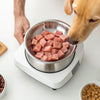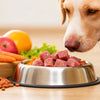Should I Switch My Dog to a Raw Food Diet? Exploring the Benefits, Challenges, and Insights
- Houndsy
Table of Contents
- Introduction
- Understanding Raw Dog Food Diets
- The Benefits of a Raw Dog Food Diet
- The Challenges of a Raw Dog Food Diet
- Transitioning Your Dog to a Raw Food Diet
- What to Expect After the Transition
- Conclusion
Introduction
Did you know that approximately 15% to 25% of dogs in the United States are currently being fed some form of raw meat-based diet? As concerns grow about the quality of commercial pet foods, many pet owners are asking themselves an essential question: should I switch my dog to a raw food diet? Transitioning to a raw diet is a hot topic in the pet care community, promising potential benefits like improved coat quality, increased energy levels, and healthier digestion. But with these advantages come significant considerations that every dog owner must weigh.
In this blog post, we’ll dive deep into the world of raw dog food diets. We'll cover what a raw food diet entails, the potential benefits and drawbacks, and how to transition your dog safely. By the end of this article, you’ll possess a well-rounded understanding of whether a raw diet might be the right choice for your furry friend. So, grab a cup of coffee, settle in, and let’s explore this intriguing topic together!
Understanding Raw Dog Food Diets
What is a Raw Dog Food Diet?
A raw dog food diet typically involves feeding your dog uncooked meat, bones, fruits, and vegetables. These diets can come in various forms, from homemade recipes curated by dedicated pet parents to commercial raw food products designed to meet nutritional standards. The raw dog food diet often aligns with the belief that dogs should eat what their ancestors consumed, mimicking a more ancestral diet composed mostly of whole prey.
Types of Raw Diets
-
Commercial Raw Diets: These can be divided into:
- Frozen raw diets: Pre-packaged raw food often sold in bulk or portioned formats.
- Freeze-dried or dehydrated raw diets: These are shelf-stable options that maintain most of the nutritional value of raw food.
- Raw meat and bone: Fresh, unprocessed meats and bones sourced from grocery stores or butcher shops.
-
Homemade Raw Diets: Creating a balanced diet at home can be more cost-effective and tailored to your dog’s needs. However, this also requires a thorough understanding of canine nutrition to avoid deficiencies.
-
BARF or PMR Diets: The Biologically Appropriate Raw Food (BARF) and Prey Model Raw (PMR) diets focus on feeding dogs a balanced ratio of meat, bones, and organs, mimicking the intact prey.
Nutritional Considerations
When considering a raw diet, it’s crucial to ensure that it meets the nutritional needs outlined by the Association of American Feed Control Officials (AAFCO). Each dog is unique, so the proportions of proteins, carbohydrates, fats, vitamins, and minerals should cater to your dog’s specific health needs, age, and activity level.
The Benefits of a Raw Dog Food Diet
Improved Coat and Skin Health
Many pet owners who have transitioned their dogs to a raw diet report shinier coats and healthier skin. The high levels of essential fatty acids found in raw meat can have a significant positive impact on skin conditions. Dogs might also experience less itching and irritation compared to when they were on a processed food diet.
Enhanced Energy Levels
A raw diet can lead to increased vitality in dogs. With less processed food and more natural ingredients, many owners notice that their dogs are more energetic and playful. This increase can be attributed to the nutritious ingredients that support overall health and well-being.
Cleaner Teeth and Fresher Breath
One of the unanticipated benefits of raw feeding is improved dental health. Chewing on raw bones can help remove tartar and plaque, leading to cleaner teeth. Additionally, many pet owners report that their dogs experience fresher breath compared to kibble-fed companions.
Fewer Health Issues
Many proponents of raw diets claim that their dogs experience fewer allergies, gastrointestinal problems, and obesity. The high-protein, low-carb nature of raw food could contribute to a healthier body weight and enhanced immune response.
Natural Food Recognition
Raw foods often contain ingredients that pet parents can easily recognize—beef, chicken, turkey, vegetables, and fruits. This simplicity appeals to many dog owners who want to know exactly what goes into their dog's meals.
The Challenges of a Raw Dog Food Diet
Risk of Nutritional Imbalance
A significant concern with homemade raw diets is ensuring they are complete and balanced. Incorrect formulations can lead to nutritional deficiencies or excess nutrients. Consulting with a veterinary nutritionist can help you create a diet that meets all AAFCO guidelines.
Bacterial Contamination
Raw meats can carry harmful bacteria such as Salmonella and E. coli, posing risks to both pets and humans. Proper food handling, cleanliness in preparation, and sourcing high-quality ingredients are essential to mitigate these risks. For example, following strict hygiene practices, such as thorough handwashing and sanitizing surfaces post-preparation, can help ensure safety when feeding raw diets.
The Transition Challenge
Transitioning from a processed diet to raw can be tricky. Some dogs may take to raw food without issue, while others might resist the change. Gradual introductions, mixing old food with new, are often recommended to ease dogs into a raw diet, preventing digestive upset.
Cost Considerations
High-quality raw ingredients can be more expensive than traditional kibble, leading to financial considerations for pet owners. It's crucial to plan out budgets and potential costs involved in switching to a raw food diet.
Not Suitable for All Dogs
Certain dogs with specific medical conditions (such as pancreatitis, severe liver, or kidney issues) may not be suitable candidates for a raw diet. Puppies also require very specific nutrients and should not be fed a homemade raw diet without expert guidance.
Transitioning Your Dog to a Raw Food Diet
Step 1: Consult Your Veterinarian
Before making any dietary changes, consult your veterinarian or a certified canine nutritionist. Discuss your dog’s health status and get guidance tailored to their unique needs.
Step 2: Gradual Transition
Whether you choose to switch quickly or gradually, here’s a basic outline for both approaches:
-
Fast Transition: If your dog is an enthusiastic eater, you may choose to switch to raw food at the next feeding. Monitor them for any signs of gastrointestinal distress and offer mixes of gut-friendly foods, like pumpkin puree, if needed.
-
Slow Transition: Begin by replacing a small portion of your dog’s current food with raw food. Gradually decrease the old food and increase the new over a span of 7 to 10 days or until your dog fully adapts.
Step 3: Monitor Your Dog’s Health
During and after the transition, closely observe your dog’s health. Look out for changes in stool consistency, energy levels, and any signs of digestive discomfort. Regular check-ins with your veterinarian can also help assess your dog's progress and adaptations to the raw diet.
What to Expect After the Transition
Once your dog has fully transitioned to a raw food diet, it’s common to observe a variety of changes, including:
-
Changes in Stool: Higher moisture content in raw food may initially result in softer stools. However, these typically normalize as your dog adjusts. Over time, many owners report firmer, smaller stools.
-
Increased Energy Levels: As discussed earlier, many dogs exhibit heightened activity and playfulness soon after the switch.
-
Improved Overall Health: You may notice fewer allergies and a healthier coat. Regular veterinary check-ups will help verify that all is well and that your dog is thriving on this new diet.
-
Detox Symptoms: Occasionally, as your dog adjusts to a raw diet, they may experience symptoms associated with detoxification, including mild loose stools, ear wax discharge, or skin irritations. These usually resolve within a few weeks.
Conclusion
The choice of whether to transition your dog to a raw food diet is certainly a personal one, influenced by each dog’s individual needs and your level of comfort with raw feeding practices. While there are clear benefits to a raw diet—like improved health, energy, and overall well-being—it is also necessary to approach the transition thoughtfully, ensuring nutritional adequacy and food safety.
We understand that as pet parents, we want the very best for our dogs. And while making dietary changes can be daunting, we encourage you to gather information, seek professional advice, and explore options that resonate with you.
As you consider how to elevate your pet feeding experience, don’t forget about incorporating convenience and design into your daily routines. Check out the Houndsy Kibble Dispenser for a sleek and functional solution that enhances your feeding rituals. By choosing a product that embodies modern design and practicality, you can complement your commitment to your dog's health.
FAQ
What are the main benefits of a raw dog diet?
Benefits may include a shinier coat, improved energy levels, cleaner teeth, better digestion, and fewer allergies.
Is a raw diet safe for all dogs?
No, dogs with specific health conditions like pancreatitis or kidney disease may not be suited for a raw diet. Always consult with your veterinarian before making dietary changes.
How can I transition my dog to a raw diet safely?
You can either transition quickly by switching completely at once or gradually by mixing raw food with current food over a week.
What types of meat are best for raw diets?
High-quality protein sources like beef, chicken, turkey, and fish are excellent choices. Ensure freshness and avoid enhanced meats with added sodium or preservatives.
Are there any risks associated with raw dog food diets?
Yes, potential risks include nutritional imbalances and bacterial contamination. It's essential to handle raw food properly and consult with nutrition experts for a balanced diet.
How can I know if my dog is adjusting to a raw diet?
Monitor for signs of improved energy, stool consistency, and overall health. Initial digestive upset can occur, but it should resolve within a week or so.
Switching to a raw food diet can be a rewarding journey for both you and your dog. By being informed and cautious, you can enhance your pup's feeding experience and overall health.












